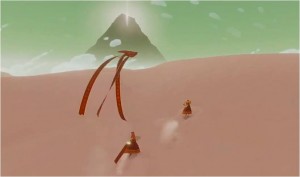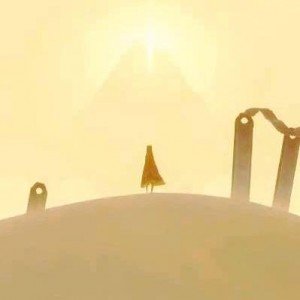A Journey of A Thousand Miles…
by Gideon, HSM team writer
WARNING: It is HIGHLY recommended that this review be read only after Journey is played. While there are no overt spoilers offered within this review, there are aspects of gameplay that are so integral to the experience that I would be dismayed if the discussion of those aspects of the game were to lessen the experience of Journey in any way, for any player.
So please, if you’re so inclined, play Journey before reading onward… this review will be here when you are done.
When a company that has a reputation for bringing unique and memorable experiences to their audience decides to deliver an adventure game, it’s enough to make any gamer sit up and take notice. As many know, the whimsy and emotive nature of thatgamecompany’s game design doesn’t lend itself to typical adventure games. There are those of you who may not have played either of thatgamecompany’s previous titles but find yourself allured by the mysticism of Journey. There are those of you that may have tried Flow or Flower (HSM Review HERE) and are cautiously looking to Journey with reserved hope for something different. There are also those that have had the pleasure of playing, and immensely enjoying these previous titles and will surely be expecting something that reaches beyond what videogames have accomplished and strive to break into something… more.
To anyone who falls into any of these categories, and to everyone else, I have four simple words for you.
You won’t be disappointed.
In an industry that is saturated with throngs of “me too” shooters and quick cash in rehashes of old titles, it’s refreshing to see a company like Sony take a chance on an independent game company and allow them the freedom to aspire, to actually achieve something, with their work. Journey seeks to prove that videogames can be a legitimate art form. Showing that a meaningful and personal experience is possible with this interactive digital medium so many of us have grown to love. Of course, Journey is not the first game that aspires to such heights.
Many recent games, even the previous titles from the independent game studio that developed Journey, have sought to provide gamers with a thoughtful and artistic experience by creating visually striking landscapes with unique gameplay elements. These games have proven that art can be expressed within videogames and that it can be an integral part of the videogame experience, but where many of these artistically aspiring titles fall short, Journey thrives.
Much of what can be said about each element of Journey can be said about the game as a whole. Elegance and simplicity permeate throughout the entirety of the experience. So much so that every individual piece of Journey works together to build a game that is far greater than the sum of its parts, and it’s difficult to consider one aspect of the game without it being influenced and enhanced by another.
At the onset of Journey, the player is draped in maroon robes and set in the middle of a desert. On the horizon, a pillar of light silently radiates from the peak of an ominous mountain. This is the beginning of a story that is told through action and inter-level cut scenes of living tapestry art that conveys a world of corruption, hardship and redemption. Within each level, the player is presented with tasks that are simple and straightforward, but never dull or tedious. Whether it is bringing old, tattered tapestries to life, reigniting long forgotten wall mosaics, scouting glowing icons, surfing sand-slides, rescuing captured sentient flying tasseled throw pillows, or escaping massive lurking beasts, gameplay variation always feels purposeful and the player never loses sight of the overlying goal, to reach the mountain.
All of this is accomplished with easy to learn controls that quickly become second nature to the player. Even though the tutorial is interwoven throughout the first few levels of Journey, it seems less as if the player is being taught controls and is more like the player is learning how to experience the world. The character moves fluidly and easily across the screen, laboring up the face of a swollen dune only to glide effortlessly down the other side. The simple act of movement is itself a core component of the experience of Journey and it is utilized masterfully from beginning to end.
 Perhaps my greatest reservation about Journey was the setting. Set in a desert, I assumed there were only so many ways deserted ruins covered in sand could be presented while still being interesting. Thankfully, through the use of a multitude of lighting effects and design choices, I couldn’t have been more wrong. Each level provides the player with a new vista to explore, each employing the sand particle physics created for this world in new and interesting ways. From bleached dunes to cascading chocolate slopes, Journey is a visually striking treat that is accompanied by an equally picturesque score that plumes and sways to draw the player deeper into the experience.
Perhaps my greatest reservation about Journey was the setting. Set in a desert, I assumed there were only so many ways deserted ruins covered in sand could be presented while still being interesting. Thankfully, through the use of a multitude of lighting effects and design choices, I couldn’t have been more wrong. Each level provides the player with a new vista to explore, each employing the sand particle physics created for this world in new and interesting ways. From bleached dunes to cascading chocolate slopes, Journey is a visually striking treat that is accompanied by an equally picturesque score that plumes and sways to draw the player deeper into the experience.
On my play-through of Journey I was fortunate enough to meet a few other players along the way. Having another player accompany me on my journey seemed integral to my experience. When our essence would run low, limiting our jumping abilities, we would huddle closely and our scarves, whipping in the wind, would shine with newfound vigor. I wasn’t provided the name of my companion until after I completed the game, which added to the fantasy of the experience.
Communication between players is accomplished easily and without any direct meaning. Using a series of long and short tones, players are able to send each other audible messages without any direct translation between the two players. Even without an established language, the player I spent my journey with seemed to know what I was trying to say with my melodic messages. At one point, I fell from a walkway and when I was finally able to catch back up to my companion I released two slow short tones to apologetically say “sorry.” To which they replied three quick tones that, to me, sounded like “That’s OK.” It was simply amazing to get a sense of communication with another individual without the use of an actual language. Never did the communication feel awkward or clumsy. Just as the rest of the experience, it was provided simply and executed easily.
 All of this, however, isn’t to say that Journey isn’t without any flaws. As majestic as this game is, the experience is far too short. While I personally feel the length is part of the experience and even feeds into the allegorical messages presented through Journey, it’s hard to ignore that the shortness of Journey is unanticipated and disappointing. Multiplayer, while graceful, provides no means for playing with specific individuals or friends. While this could, again, be a deliberate design choice to foster a sensation of wonder and discovery, it’s hard to swallow that online play is limited to strangers passing in the desert.
All of this, however, isn’t to say that Journey isn’t without any flaws. As majestic as this game is, the experience is far too short. While I personally feel the length is part of the experience and even feeds into the allegorical messages presented through Journey, it’s hard to ignore that the shortness of Journey is unanticipated and disappointing. Multiplayer, while graceful, provides no means for playing with specific individuals or friends. While this could, again, be a deliberate design choice to foster a sensation of wonder and discovery, it’s hard to swallow that online play is limited to strangers passing in the desert.
Despite these two issues, Journey easily earns my highest recommendation. This game is as unique as it is beautiful and will provide an experience unlike any other. While it would be easy to demerit Journey half a point, or more, for its multiplayer design and length, I simply do not feel as if the entirety of the experience warrants a less than perfect score. When I finished the game, I found myself touched by the experience and, again sitting in the middle of the desert at the onset of the game, I reflected on the journey I had just taken. Although it passed quickly, I felt like I had experienced something unique and deeply personal. What I have taken from my journey is likely different from what you will take from yours. The meaning of the message is up for personal reflection and interpretation. In this way Journey delivers something few, if any, games have delivered before.
“thatgamecompany designs and develops artistically crafted, broadly accessible video games that push the boundaries of interactive entertainment. We respect our players and want to contribute meaningful, enriching experiences that touch and inspire them.”
-thatgamecompany’s missions statement





I want it! I need to see it.
Holding my spot here for when I come back in a week. Right now I am envious of plus members.
Sounds like an interesting experience Gideon. I might give it a try sometime. It looks very different visually, but that is what this company has produced before in its games. Nice review.
This is my placeholder. I have been looking forward to this game since I heard about it last Summer. I actually considered getting plus just for it, but I guess I will just have to be patient.
Same here Ted. Getting an early crack at Journey would be the price of Plus for me.
I was on Twitter Tuesday night and ThatGameCompany tweeted that the game was now open, I downloaded the game right away, in case they changes their minds!
I Loved the game! What an amazing experience. The mood, the music, the shifting sands, it was all done so well. I even like how the game ended and put you right where you started again,it reminded me of Roland’s epic quest in the Dark Tower series of books. Journey had a wonderful emotional impact for me and I can’t wait to play it over again! Great article Gid
I must admit that the ending caught me much by surprise and I agree that it is much too short. The graphics and music is phenomenal. The trip up the falls is truly majestic. My first time through I did not explore much. Next time through I will take my time; there are many more trophies to get. It is a unique experience to try to communicate and experience the game with another player without verbal communication. I too realized that you can energize each other when you need a charge to fly and climb. There should be more games of this genre, where the experience, the journey if I may, is the most important aspect of the game. I have enjoyed the other games that Jenova Chen and Kellee Santiago have produced: Cloud, Flow and Flower and Journey is a great one in this evolution of this game genre.
So I’m back after two playthroughs.
There’s an elegant simplicity to Journey. But don’t mistake its simplicity for easy-ness.
There is a *profound* beauty in this game -- from the way you cross paths with players unknown (until the end credits) to the way the story is told with no words and yet *still* move you.
It is a game that reminds you that certain moments, certain places, certain people -- certain *lives* -- no matter how brief can make a lasting impression.
Journey has made a lasting impression on me, and it will be one I’ll be revisiting. It takes everything we currently know about gaming -- endless expansion packs, hours of grinding through levels, whole years lost in the completion of one start-to-finish session -- and just turns it on its head. If this is the future of gaming, then sign me up.
I don’t think my first reaction to a game has ever been, “That’s beautiful,” but that was exactly my reaction to Journey, time and time again. If it has a fault, it’s that it may be a little too easy to get through, but what it lacks in slam-bang action challenge it more than makes up for with storytelling that encourages the player to fill in the blanks. What you get in the cutscenes, and what you get from them, depends very greatly on how you see the world, though those who have studied Buddhism will certainly see the echoes throughout the experience.
This may be the best multiplayer game on the market right now, because it solves the problems inherent in multiplayer: Griefers, cheaters and potty mouths need not apply, because there is no immediate way for you to harass anyone in this game. There’s also none of the imbalance that makes people shy away from multiplayer, because the objectives in the game require only the skills of timing and character control, both of which are easily learned.
This probably isn’t a game that anyone will sink hours into at a time. Rather, it’s a delightful change of pace that offers engaging, relaxing enjoyment whenever it’s called to life from the XMB,
I can’t say enough for it, or the innovative Home space that drops people into a recreation of the environment while limiting how they can interact, to make the Home space more like the game. You’ll actually get a good taste of what this game is like from its Home space, and I recommend paying that space a visit if you’re on the fence about owning this game.
I just finished my first playthrough of “Journey”. This is one of the few games that had me literally weeping at the end, with the sheer depth of emotion. The sense of other beings in your companions is acute and compelling. The first companion I found patiently led me around the level, making sure that I had experienced everything before I moved on. I am tempted to write down the user names displayed at the end, and send each of them a thank-you note.
My only problem was constant, severe video glitches — flashes, grids, flares, invisible lines revealed and so on. I don’t see this in any other game (though the flashes sometimes happen in Home), and I don’t think the game would have been released if this were a common problem. It has to be something about my system — perhaps the fact that I’m filtering output through a Hauppauge. If anyone knows what is happening, I would appreciate the information — and suggestions for how to correct it. This game is too good to be ruined by visual distractions.
The obvious question is how well “Journey” stacks up against “Flower”. In many ways, I think “Flower” is a greater game, and a greater work of art. But the innovative multiplayer elements in “Journey” set this game apart — not only from “Flower”, but from all other games I have experienced. It captures the wonder and mystery of human communication with a profundity that I did not think possible in this medium. Paradoxically, the communication is stronger because it is wordless. In this way, “Journey” is the perfect metaphor for our own journey through life. We are surrounded by other beings whose inner lives are mysteries, but still manage to touch us, using the few blunt tools we have been given.